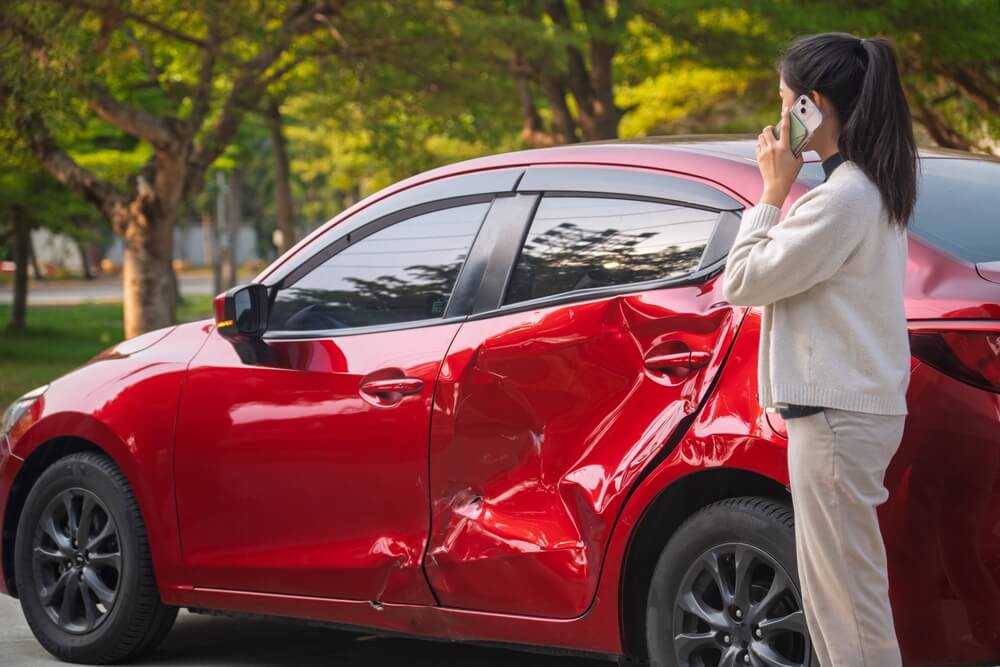
If you are not redirected within 30 seconds, please click here to continue.
Samedi: 10h – 16h HAE

If you are not redirected within 30 seconds, please click here to continue.
If you are not redirected within 30 seconds, please click here to continue.
Demystifying Direct Compensation – Property Damage Coverage

The realm of auto insurance can be like deciphering a codex, especially when acronyms like DCPD flash across the screen.
However, understanding the importance of Direct Compensation - Property Damage (DCPD) is vital, especially for Ontarians. It’s been a mandatory coverage to drive in Ontario, but starting January 1, 2024, drivers in Ontario have been able to opt out of this coverage.
However, it remains essential for adequate protection on the roads. It offers benefits like a quicker claims process and dealing directly with your insurer, avoiding unnecessary delays with your claim and car repairs.
Keep reading for more information on DCPD, and why you shouldn’t go without it.
Understanding DCPD
Direct Compensation - Property Damage is an essential part of car insurance in Ontario. It’s set up to simplify the claims process and to protect you, the driver.
If your vehicle happens to be damaged in a collision caused by another driver, you'll file a claim with your insurer, regardless of who’s at fault. This speeds up the repair process and reduces stress.
DCPD covers the cost of repairing your car, excluding injuries. It also ensures you get your vehicle fixed quickly, providing you have the third party’s information and they are insured. It also provides you with a rental replacement, and transportation costs, and covers the personal contents in your car.
How do I opt in or out of DCPD?
DCPD coverage is automatically included in your policy, so you’re already protected. If you choose to opt out, simply request a form (called OPCF 49) from your insurer and fill it out to exclude this coverage. Keep in mind that opting out means you won’t be able to make a claim to be reimbursed for vehicle damage, its value, loss of use or personal contents in the car if you’re in a collision and not at fault.
The mechanics of DCPD
Customers can typically purchase DCPD with or without a deductible. If you do choose to have a deductible, the maximum is usually $500.
Opting for DCPD coverage with a deductible can be an option for people looking to customize their auto insurance policy based on their needs and financial preferences.
These reasons can include:
- Cost savings: Choosing a higher deductible results in lower insurance premiums. By accepting a higher financial responsibility in the event of a claim, you can reduce your overall insurance costs.
- Risk tolerance: People with a higher risk tolerance may be willing to take on a larger share of the burden in the event of an accident.
- Customization: Opting for a deductible allows policyholders to customize their insurance coverage to align with their budget and preferences.
- Financial planning: Some people prefer to have more control over their insurance costs and plan for potential out-of-pocket expenses.
- Incentive for safe driving: Knowing that they will be responsible for a portion of the repair costs may incentivize policyholders to drive more cautiously and take steps to prevent accidents.
Remember, it’s important for you to carefully consider your financial situation and driving habits when selecting insurance coverage and choosing the amount you pay for their deductible. Additionally, you should review and understand the terms and conditions of the insurance policy to make the decisions that are best for you.
How does a DCPD deductible work?
If you’re 0% at fault, you’re covered based on your selected deductible. There is no DCPD coverage if you’re 100% at fault, but collision coverage (if purchased) compensates you in that scenario. If you’re, for instance, 25% at fault in an incident, DCPD will cover 75% of the claim, applying the deductible, and collision would cover the remaining 25%, minus its deductible.
Common misconceptions
One common misconception about DCPD is that it covers bodily injury. However, it's essential to note that DCPD specifically addresses property damage and contents. For bodily injury coverage, drivers need to look to other coverages, such as Third-Party Liability.
How does DCPD affect your premium?
The cost of DCPD depends on a few factors, including your driving history, and vehicle, as well as deductible and coverage limits you select.
Some may consider opting out to save on their premium, but the risk usually isn’t worth it. The potential savings by opting out of DCPD coverage would depend on various factors, including the specific insurance provider, the insured individual’s driving history, the type of vehicle and the coverage limits chosen.
If you’re looking to save on your monthly cost of car insurance, consider options like:
- Review your policy to make sure you are taking advantage of all possible discounts.
- Consider your deductible. Increasing your deductible may help reduce your overall premium, but it’s important to remember that this can increase your out-of-pocket cost in the event you need to submit a claim.
- Review your coverages to ensure that the options you’ve included in your policy are best suited for your lifestyle.
- Stay safe and maintain a clean driving record. A great overall driving record can lead to a better rate.
DCPD in Ontario
Part of no-fault insurance, DCPD streamlines the claims process, ensuring that drivers receive compensation for property damage without the need for prolonged fault determination procedures.
It also offers a layer of protection against property damage. Considering the unpredictable nature of accidents, having DCPD coverage ensures that drivers can swiftly address damages to their vehicles and personal belongings, contributing to a faster recovery process.
DCPD is also available in Quebec, Nova Scotia, New Brunswick, and PEI.
Determining who's at fault
To better understand how DCPD functions, it’s important to learn about fault determination rules. These rules dictate who is considered at fault in the event of a collision. In Ontario, fault determination is a structured process that helps insurers assess responsibility and facilitates a fair resolution of claims.
For instance, if a driver rear-ends another vehicle, the fault may lie with the driver who failed to maintain a safe distance. Understanding these rules is necessary for drivers to anticipate the potential impact on their insurance claims.
Onlia prioritizes fair outcomes for customers by determining who’s at fault. We use technology and data to assess it accurately, ensuring that claims are settled equitably.
What you need to know
In the often confusing world of auto insurance, DCPD is the coverage that upholds efficiency and protects drivers in incidents that aren’t their fault. Understanding its mechanics, coverage, and reach empowers drivers to make informed decisions about their insurance needs.
As you drive on Ontario's roads, consider the advantages of DCPD coverage. It's not just insurance; it's a reliable companion that ensures swift recovery in the face of unexpected accidents. Learn more about DCPD coverage and related insurance options to drive with confidence knowing that you're protected in Ontario's dynamic automotive landscape.
Get money-saving tips in your inbox.
Stay on top of personal finance tips from our money experts!









